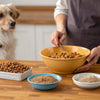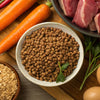What to Do If Your Dog Won't Eat Kibble: A Comprehensive Guide for Concerned Pet Owners
- Houndsy
Table of Contents
- Introduction
- Understanding the Reasons Behind a Loss of Appetite
- Steps to Take When Your Dog Won't Eat Kibble
- Alternatives to Kibble
- Conclusion
Introduction
Picture this: you’ve just placed a freshly filled bowl of kibble in front of your furry friend, brimming with anticipation, only to watch as they turn their nose up and walk away. It’s a heart-wrenching moment that many of us pet owners have faced. In fact, studies show that approximately 20% of pet owners experience feeding issues with their dogs at some point in their lives. This troubling behavior can stem from various reasons, and understanding them is crucial to ensuring our canine companions remain healthy and happy.
In this blog post, we aim to equip you with practical knowledge and insights into what to do if your dog won’t eat kibble. We’ll explore potential reasons behind your dog’s sudden aversion to their food, discuss dietary alternatives, and share tips on how to entice your pup back to mealtime. By the end of this post, you’ll have a well-rounded understanding of the steps to take when faced with a picky eater and the importance of maintaining a balanced diet for your dog’s well-being.
Let’s dive into the heart of this issue and discover how we can transform mealtime from a source of stress into a harmonious experience for both you and your beloved pet.
Understanding the Reasons Behind a Loss of Appetite
Medical Reasons Your Dog Might Not Eat
One of the first things we should consider when our dog refuses to eat is their health. A sudden change in appetite can often signal underlying medical issues. Here are some common health-related reasons your dog might not be eating:
- Dental Problems: Dogs can experience painful dental issues, including gum disease or broken teeth, which may make it uncomfortable for them to chew kibble.
- Gastrointestinal Disturbances: Stomach issues, including nausea or upset stomach, can lead to a lack of appetite. Pay attention to any accompanying symptoms like vomiting or diarrhea.
- Chronic Illness: Conditions such as kidney disease, liver problems, or even cancer can affect a dog’s appetite. If your dog seems lethargic or unwell, it’s crucial to consult your veterinarian.
- Medications: Some medications can cause side effects that affect a dog’s appetite. If your dog has recently started a new medication, discuss this with your vet.
Behavioral Reasons for Picky Eating
In addition to medical issues, behavioral factors can also play a significant role in a dog’s eating habits:
- Routine Changes: Dogs thrive on routine, and changes in their environment or schedule can lead to stress, causing them to lose interest in food.
- Overfeeding: If a dog is frequently offered treats or table scraps, they may become less inclined to eat their regular kibble, leading to pickiness.
- Boredom with Food: Dogs, like humans, can experience food fatigue. If they eat the same kibble day after day, they may simply lose interest.
- Fear or Anxiety: New situations, loud noises, or unfamiliar environments can make a dog feel anxious, leading to a refusal to eat.
Steps to Take When Your Dog Won't Eat Kibble
1. Rule Out Medical Issues
If your dog suddenly stops eating their kibble, the first step should be a visit to the veterinarian. They can perform a thorough examination to rule out any underlying health problems. Remember, early intervention is key to addressing potential issues.
2. Evaluate Their Feeding Environment
Observe your dog during mealtime. Is their bowl in a noisy area? Do they feel comfortable eating around other pets? Sometimes, simply relocating their feeding station to a quieter, more private area can help reduce anxiety and encourage them to eat.
3. Check Your Dog’s Kibble
Ensure the kibble you’re providing is fresh and of good quality. Check for the expiration date and inspect the kibble for any signs of spoilage or off odors. Dogs are sensitive to the freshness of their food, and stale kibble may not appeal to them.
4. Make Mealtime More Appealing
Consider the following strategies to entice your dog to eat:
- Add Toppers: Enhance the flavor and aroma of kibble by adding dog-safe toppings such as unsweetened canned pumpkin, yogurt, or bone broth. These additions not only make the kibble more enticing but also provide added nutritional benefits.
- Warm the Food: Gently warming your dog's kibble can enhance its scent, making it more appealing. Just ensure it’s not hot before serving.
- Switch Up Textures: If your dog is accustomed to dry kibble, consider mixing in some wet food or trying a different brand or flavor of kibble. Dogs often enjoy variety and new flavors.
5. Establish a Feeding Routine
Set a consistent feeding schedule for your dog. Offer food at the same times each day and leave it out for a limited period (15-30 minutes). This approach can help train your dog to recognize mealtime and encourage them to eat when the food is available.
6. Minimize Treats
If your dog is getting too many treats throughout the day, they may be less inclined to eat their kibble. Ensure treats make up no more than 10% of their daily caloric intake, and consider cutting back on these extras to encourage them to eat their main meals.
7. Incorporate Interactive Feeders
Using puzzle feeders or slow feeders can turn mealtime into a fun challenge for your dog. These interactive feeding tools stimulate your dog’s mind and can encourage them to eat more eagerly.
8. Provide Plenty of Fresh Water
Dehydration can also affect a dog’s appetite. Ensure your dog has access to fresh, clean water at all times. Consider adding a splash of low-sodium broth to their water to entice them to drink more.
9. Monitor for Changes
Keep an eye on your dog’s behavior and appetite. If they continue to refuse food or show signs of distress, it’s essential to consult your veterinarian for further guidance.
Alternatives to Kibble
If your dog remains uninterested in kibble, it may be time to explore alternative diets. Here are some options to consider:
Canned Dog Food
Canned dog food can be a tasty alternative for dogs who turn their noses up at dry kibble. It often has a richer flavor and moisture content, making it more appealing. Just like with kibble, choose high-quality brands with good nutritional profiles.
Fresh Dog Food
Increasingly popular among pet owners, fresh dog food options provide a more natural and nutritious alternative. Companies like Ollie offer personalized meal plans based on your dog’s specific needs, ensuring they receive balanced nutrition without fillers.
Homemade Diets
Preparing homemade meals for your dog can be a rewarding option, but it’s essential to consult with a veterinarian or a qualified pet nutritionist to ensure that your dog’s meals are balanced and meet their dietary needs.
Raw Food Diets
Some owners opt for raw food diets, which consist of uncooked meat, bones, and vegetables. While proponents argue it mimics a dog’s natural diet, it’s crucial to consult your vet before transitioning to ensure safety and balance.
Conclusion
In conclusion, when faced with the frustrating situation of our dogs refusing to eat kibble, it's essential to approach the issue with patience and understanding. By considering potential medical reasons, reevaluating feeding practices, and exploring dietary alternatives, we can support our furry friends in maintaining a balanced and enjoyable diet.
As we strive to elevate our pet care experience, we can also look to innovative solutions like the Houndsy Kibble Dispenser. Designed with functionality and style in mind, this dispenser not only helps manage portions but also complements modern home decor. With its ergonomic design and reliable features, the Houndsy Kibble Dispenser ensures that mealtime remains a delightful routine for both you and your pup.
If you’re looking to enhance your dog’s feeding experience, we invite you to explore the Houndsy Kibble Dispenser and discover how it can simplify your pet care routine.
FAQ
Q: What should I do if my dog won’t eat for more than 24 hours?
A: If your dog hasn't eaten for more than 24 hours, it’s important to consult your veterinarian, especially if accompanied by other symptoms such as lethargy, vomiting, or diarrhea.
Q: Can I mix wet food with dry kibble?
A: Yes! Mixing wet food with dry kibble can make meals more appealing and provide additional moisture. Just ensure the overall calorie content remains balanced.
Q: Are there any safe human foods I can add to my dog’s meal?
A: Yes, safe options include plain cooked chicken, carrots, green beans, and unseasoned pumpkin. Always consult with your vet about new additions to your dog’s diet.
Q: How can I tell if my dog is simply being picky?
A: If your dog eats treats or other foods but refuses their kibble, they may be exhibiting pickiness. However, it’s crucial to rule out medical issues first.
Q: What are the signs of dental problems in dogs?
A: Signs include difficulty eating, bad breath, excessive drooling, and visible tartar buildup. Regular dental check-ups are essential for maintaining your dog’s oral health.
By following these insights and strategies, we can ensure that our dogs enjoy their meals and receive the nutrition they need for a healthy, happy life.












